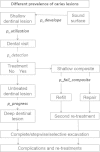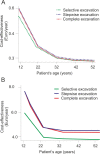Cost-effectiveness of caries excavations in different risk groups - a micro-simulation study
- PMID: 25511906
- PMCID: PMC4279684
- DOI: 10.1186/1472-6831-14-153
Cost-effectiveness of caries excavations in different risk groups - a micro-simulation study
Abstract
Background: Whilst being the most prevalent disease worldwide, dental caries is increasingly concentrated in high-risk populations. New caries treatments should therefore be evaluated not only in terms of their cost-effectiveness in individuals, but also their effects on the distribution of costs and benefits across different populations. To treat deep caries, there are currently three strategies: selective (one-step incomplete), stepwise (two-step incomplete) and complete excavation. Building on prior research that found selective excavation generally cost-effective, we compared the costs-effectiveness of different excavations in low- and high-risk patients, hypothesizing that selective excavation had greater cost-effectiveness-advantages in patients with high compared with low risk.
Methods: An average tooth-level Markov-model was constructed following the posterior teeth in an initially 18-year old male individual, either with low or high risk, over his lifetime. Risk was assumed to be predicted by several parameters (oral hygiene, social position, dental service utilization), with evidence-based transition probabilities or hazard functions being adjusted for different risk status where applicable. Total lifetime treatment costs were estimated for German healthcare, with both mixed public-private and only private out-of-pocket costs being calculated. For cost-effectiveness-analysis, micro-simulations were performed and joint parameter uncertainty introduced by random sampling of probabilities. Cohort analyses were used for assessing the underlying reasons for potential differences between strategies and populations.
Results: Selective excavation was more effective and less costly than both alternatives regardless of an individual's risk. All three strategies were less effective and more costly in patients with high compared with low risk, whilst the differences between risk groups were smallest for selective excavation. Thus, the cost-effectiveness-advantages of selective excavation were more pronounced in high-risk groups, who also benefitted the most from reduced private out-of-pocket treatment costs.
Conclusions: Whilst caries excavation does not tackle the underlying sources for both the development of caries lesions and the potential differences of individuals' risk status, selective excavation seems most suitable to treat deep lesions, especially in patients with high risk, who over-proportionally benefit from the resulting health-gains and cost-savings.
Figures




References
-
- Petersen PE. World Health Organization global policy for improvement of oral health–World Health Assembly 2007. Int Dent J. 2008;58:115–121. - PubMed
-
- Schiffner U, Hoffmann T, Kerschbaum T, Micheelis W. Oral health in German children, adolescents, adults and senior citizens in 2005. Community Dent Health. 2009;26:18–22. - PubMed
Pre-publication history
-
- The pre-publication history for this paper can be accessed here:http://www.biomedcentral.com/1472-6831/14/153/prepub
Publication types
MeSH terms
LinkOut - more resources
Full Text Sources
Other Literature Sources
Medical

